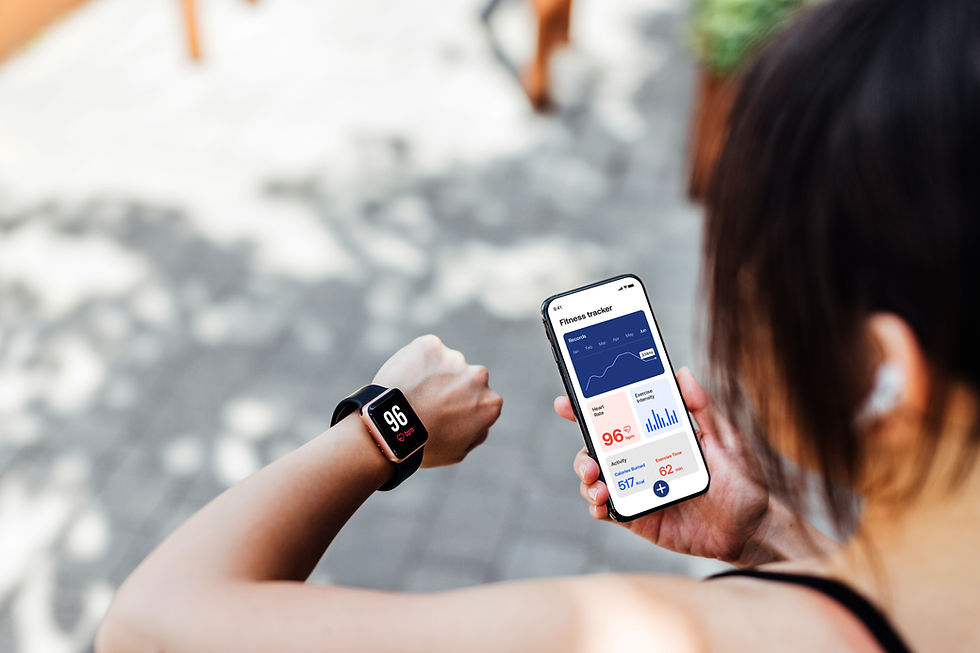Could We Be Relying Too Much On Extrinsic Feedback?
- Brian Jordan RSCC*E, CSCS
- May 18, 2023
- 5 min read
Updated: Mar 5, 2024
If you've been watching a Major League Baseball game in recent years then you've probably seen players looking at an iPad in the dugout after an at bat. Pitchers will look at video and the pitch data from data capture systems as they throw bullpens or get ready to pitch in games. These are just a few examples of non-verbal extrinsic feedback that is very prevalent in sports like baseball. Extrinsic feedback is information provided to the athlete from an outside source. While non-verbal feedback has grown in it's use by elite level athletes due to the development of new technology, the most common extrinsic feedback is still verbal feedback that is provided by a coach or instructor. Another source of feedback that athletes use to learn and refine sport skills is intrinsic feedback. Intrinsic feedback is internal sensory feedback that an athlete experiences when performing sport skills, like seeing a ball go in the glove and feeling the ball released from their hand. (1)

When athletes begins to learn new skills, they rely on both extrinsic and intrinsic feedback. As they become more experienced and advanced with their skills, elite athletes have a tendency to rely more heavily on extrinsic feedback. Specifically, non-verbal feedback like video analysis and performance analytics (e.g. launch angle, defensive efficiency), are preferred by the more experience athlete. They have the understanding of what to look for and the ability to make the appropriate adjustment when reviewing video; whereas with the more inexperienced athlete, this can be too much information and negatively effect skill development. Younger and less experienced athletes have shown to perform better with both verbal external feedback and intrinsic feedback (e.g. feel, see). By using both extrinsic and intrinsic feedback, this allows for the athlete to work through mistakes and solve problems with information provided to them and through what they process internally. (1)
Now, with the highest levels of sport using the system where athletes are predominately being coached by video and performance data, we are now seeing a similar system exist in the earlier stages of athletic development. While there are benefits to having a more extensive feedback system, one could question if this extensive reliance on extrinsic feedback is hindering the athlete's ability to make adjustments in the moment when extrinsic feedback is not present and intrinsic feedback has not been prioritized in the development system. Many young athletes today, are being developed to rely extensively on technology and verbal cueing from coaches. In doing so, young athletes are not learning how to utilize the information from their own senses to reinforce motor skills or to make adjustments. How many times lately have you seen an athlete being critiqued by a coach or parent in the middle of a game situation? Again, verbal feedback is important when developing technical sport skills but can be detrimental to long term learning when athletes become dependent on this source of

feedback. One's ability to internally process and apply information while competing in sports, is arguably more impactful than technical critiquing by a coach when in the moment. Take a baseball or softball hitter for example. During an at bat, the hitter needs to process the speed, movement and location of the ball being thrown while coordinating their body to hit the pitch. In that moment of hitting a pitch, there's the requirement of internally processing information and decision making, that's separate from any extrinsic feedback that could be provided. And yet, there are coaches that insist on constantly giving verbal feedback instead of allowing the athlete to optimize their own internal feedback system. Now granted, these coaches believe they're helping the athlete by providing feedback in this situation. But what many don't realize is that research has shown that error-correcting feedback can have a dependency-effect. By providing constant verbal feedback, the coach is actually inhibiting the athlete's ability to perform without their feedback. Thus, if the feedback is wrong or isn't available, then the athlete's performance will likely suffer. (1)
Along with extrinsic and intrinsic feedback, there are two other types of feedback called terminal and concurrent feedback. Terminal feedback is feedback provided after an event or performance in order for the athlete to review and make adjustments prior to the next event or performance. Concurrent feedback is feedback that occurs during competition and allows for adjustments to be made by the athlete in real-time. Terminal feedback in sports can be a review of video, game stats or a discussion with a coach, as a few examples. Because this use of feedback occurs after, it can be valuable for athletes to evaluate their overall performance. With concurrent feedback, it is possible to be in the form of extrinsic visual and verbal feedback as well as being intrinsic feedback an athlete experiences, like catching a ball while playing. Though extrinsic concurrent feedback has shown it can be beneficial to practice performance, it has also been found to have a negative effect on retention and transfer of performance outside of practice. With that being said, it's important not to become overly dependent on extrinsic concurrent feedback, whether your an athlete or a coach.
While a lot of this discussion has pertained to the development of skills and performance in sports; another part of this discussion is the role extrinsic feedback has on athlete load management. As mentioned previously, advancements in technology has provided greater amounts and types of feedback. Athletes today can get immediate feedback on their physiological and neurological state. Whether that be heart rate, hydration, reaction time, etc.. the athlete, coach or medical practitioner can use this information to evaluate and make decisions about practices, games, training or recovery.

Obviously, this information can be extremely useful in guiding decisions regarding health and performance. No longer is the physical status of an athlete as subjective as it once was. But could there be some drawback to consider when using biosensors and physiological assessment tech? What impact does this type of extrinsic feedback have on the athlete's ability to intrinsically assess and make decisions based on what they're feeling in the moment? Can they pace or push themselves in the absence of these devices or feedback? Is there a mental cost of an athlete knowing their precise physiological status? These are all questions that need to be asked when we look at athletic development and sports performance. While we have a tendency in sport to think that more is better; more information...more coaching...more structure....etc.. there's usually a trade-off or cost for increasing something. By increasing the reliance on extrinsic feedback to determine physiological status, could we be decreasing the ability to assess using our senses? (2)
So, what do you think?
I believe that in sports like baseball, softball and golf, there's a trending reliance on extrinsic feedback which is limiting long-term development and hindering performances. By predominately learning through verbal and video/data feedback used in practice but is not available for practical use or provided in-game when feedback is needed, makes it difficult to carryover practice performance into games and for the athlete to make on the fly adjustments that most sports require for success. Now, this is not the case for all sports. Some sports are not so reliant on providing or utilizing extrinsic feedback in practice or games but instead there's a balance between both extrinsic and intrinsic feedback as well as use of terminal and concurrent feedback. So, if we as coaches and athletes better understand the impact that extrinsic feedback can have on development and game performances and the value of balancing this with intrinsic feedback; then there's a better opportunity for sustainable long-term development and success.
References:
1.) Richard A. Schmidt, Craig A. Wrisberg Motor Learning and Performance: A Situation-based Learning Approach, Human Kinetics, 2008.
2.) Silvia Erika Kober, Manuel Ninaus, Matthias Witte, Finn Buchrieser, Doris Grössinger, Florian Ph.S. Fischmeister, Christa Neuper, Guilherme Wood, Triathletes are experts in self-regulating physical activity – But what about self-regulating neural activity?, Biological Psychology, Volume 173, 2022.





Comments